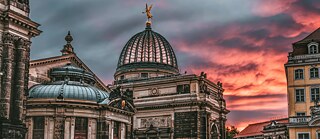Florence on the Elbe
Dresden has a long history as the capital and royal residence of the kings of Saxony who for centuries furnished the city with cultural and artistic splendor. Because of its architectural beauty Dresden is also called the “Florence on the Elbe”.
Dresden in Ruins
In February 1945, bombing raids by waves of British and American bombers rained some 650,000 incendiary bombs on the city, leaving much of it in ruins within a matter of hours and killing an estimated 30,000 civilians in a ferocious firestorm. The “Frauenkirche” (Church of Our Lady), a masterpiece of Baroque architecture dominating the city’s skyline since its completion in 1743, was completely destroyed.
Dresden Rebuilt
The “Frauenkirche” has been reconstructed as a symbol of reconciliation between former warring enemies, by privately raised funds and with the assistance of donations from around the world. One of the craftsmen rebuilding the church was the son of a British pilot involved in the Dresden raid.
A Cheap and Fast Way to Build
The massive destruction of World War II left 18.4 million East Germans in need of an apartment. East Germany’s communist government launched a housing campaign for the mass production of pre-fabricated apartment blocks (“Plattenbau”). In Dresden’s neighborhood Gorbitz alone thousands of residents found a new home. Today it’s mainly the less affluent who can’t afford the high downtown rents who live in a “Plattenbau.”
Dresden under Water
The Elbe River is one of the major rivers of central Europe. It runs from the Czech Republic through Germany to the North Sea. In August 2002 a 100-year flood caused by over a week of continuous heavy rains ravaged Europe, killing dozens, dispossessing thousands, and causing damage of billions of euros. In Dresden the Elbe reached an all-time high of 9.4 meters. More than 30,000 people were evacuated and some of the city's cultural landmarks were at risk.
The First Toothpaste
Pharmacist Ottomar von Mayenburg is the man responsible for healthy teeth. In 1907, he produced a toothpaste he named "Chlorodont". Enriched with a touch of peppermint for flavor, von Mayenburg filled the paste directly into flexible metal tubes. And ever since then we’ve been brushing our teeth regularly after breakfast and before bedtime…
A Skater’s Paradise
Every Friday night from April through October, some 3000 inline skaters meet in Dresden. They skate past all the impressive sights of the city – the ultimate city tour. This tradition goes back to 1998. The “Dresdner Nachtskaten” is considered the first event of its kind in Germany and the third worldwide. The tour is accompanied by music and catering trucks and takes about two hours.
Loved around the World
Dresden has 13 sister cities in Europe, Africa, America and Asia to promote cultural and commercial ties. The partnership with Columbus, Ohio was formalized in 1992 and since then there have been regular exchanges between universities and schools, athletes and artists in both cities.
East German Champs
Dynamo Dresden was founded in 1950 as a club affiliated with the East German police and was one of the most popular teams in East Germany. Dynamo won eight titles in East Germany’s top league, the “Oberliga” and was also quite successful in European competitions. After the reunification of Germany Dynamo played four seasons in Germany’s Bundesliga. Since then the club has drifted between the second and fourth divisions hoping for better days.
The Bridge
Before World War I German Expressionism was one of the most important artistic movements in Europe. Part of this movement was Die Brücke (The Bridge) established in 1905 in Dresden. Members included Ernst Kirchner and Erich Heckel. The artists used emotional images of the modern city to convey a world of hostility and alienation. The more conventional atmosphere of Dresden proved not to be receptive to the artists' work and the group relocated to Berlin.
